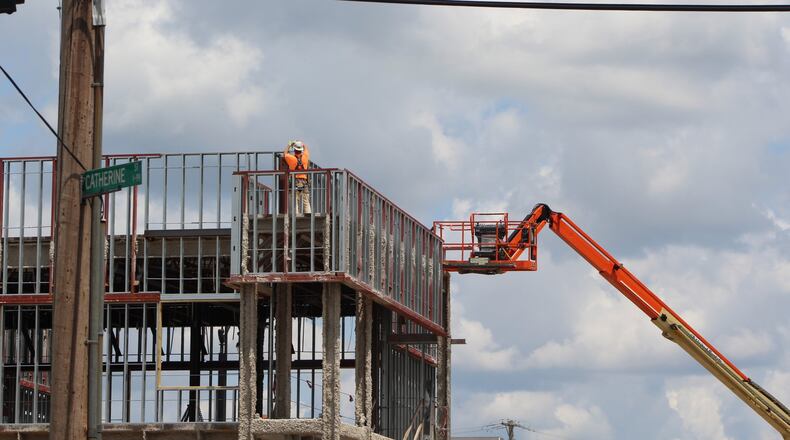“After relatively rapid growth in 2017 and slow growth in 2018, there was virtual stagnation in the last eight months,” said Richard Stock, director of the Business Research Group at the University of Dayton.
MORE: Dayton area ranked No. 2 in nation for economic development projects
Still, some encouraging pockets of growth include manufacturing and construction, and the region continues to have a tight labor market, which has helped push up wages in the last year.
Dayton, which represents 25 percent of the total regional employment base, is seeing solid growth in income tax collections in the first half of the year, said Diane Shannon, Dayton’s director of procurement, management and budget.
Jeff Hoagland, president and CEO of the Dayton Development Coalition, said growth in some industry sectors has slowed, but that’s likely because the economy is close to full employment.
This year has been busy for project activities and new leads that suggest more jobs are on the way, Hoagland said.
“We’ve seen a steady, upward turn of jobs and capital investment in our 12-county region,” he said. “We’re still seeing a good, solid economy.”
MORE: How do we get the economy to boom for all?
How Dayton compares
Nonfarm payrolls in the Dayton metro area increased by 900 jobs between June 2018 and June 2019, according to preliminary and not seasonally adjusted data from the U.S. Bureau of Labor Statistics. The Dayton region, the fourth largest metro in the state, consists of Montgomery, Miami and Greene counties.
The 0.2 percent growth was the poorest performance of Ohio’s metro areas, except for the Youngstown region (-1.4 percent decline in employment), the data show.
The Cincinnati metro area had the strongest payroll growth (2.2 percent) and Springfield ranked second best (1.8 percent).
Ohio has 11 metro areas, not counting the Weirton-Stubenville region, according to the BLS.
Year over year, the Dayton metro area posted jobs gains every month between September 2013 and September 2018, according to not seasonally adjusted data.
But job growth ground to a halt in October 2018, and the region shed jobs in November and December of last year, and payrolls also shrank in January (0.1 percent decrease), March (-0.2 percent) and April (-0.1 percent).
Toledo and Youngstown are the only other Ohio metro areas to lose jobs, year-over-year, in any month of 2019.
Construction, warehouse jobs grow
The Dayton area’s best-performing sectors last month included construction, mining and logging (+3.7 percent growth from June 2018) and manufacturing (+2.1 percent).
Goods producing employment increased 2.5 percent, and the transportation, warehouse and utilities sub-sector has seen 2.4 percent growth.
Growth in these areas is encouraging because the region has been repositioning itself as a hub of logistics, distribution and advanced manufacturing, officials say.
Other sectors are not doing so well.
Local employment has decreased by 3.6 percent in the information sector and by 1.6 percent in financial activities.
Jobs in administrative, support and waste management and remediation services have declined by 5.7 percent.
The region’s labor market is extremely tight, considering its unemployment rate was 3.4 percent in May, experts say. The tightening is likely to continue as workers retire, which should put upward pressure on wages.
“Since we are moving into that time period where baby boomers are starting to retire at a more rapid rate, I wonder if part of the slowdown we’re seeing is companies making decisions not to replace employees in positions that are at a lower skill level,” Stock said.
Where the jobs are
The city of Dayton, which is the region’s largest employment center, is seeing growing investment and jobs in the greater downtown area, as well as at the Dayton International Airport and among its major institutions, said Shannon.
Shannon noted that the June data is preliminary and subject to revision.
MORE: Strong economy forces local employers to scramble to find workers
Also, residents cross county lines for work, and some people who live in the Dayton metro area work in Clark County (the Springfield metro area), Cincinnati and other areas that have seen stronger job growth.
The Dayton Development Coalition says there have been about 1,700 new job commitments so far in its coverage area in 2019, which is a better pace than some past years.
JobsOhio western region, which covers 12 counties, had 3,880 new job commitments in 2018.
“When we look at our numbers … the JobsOhio projects we’ve worked on this year, our numbers are actually higher than last year at this point in time — almost double,” said Hoagland.
About the Author

